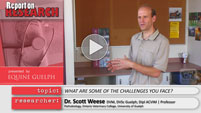ARCHIVE EQUINE NEWS STORIES
| Current news is available at TheHorsePortal.ca, Equine Guelph's online learning platform for practical, quick learning. Given the vast amount of information on horse health and welfare, Equine Guelph has archived its past news articles from 2002-2020. They are listed below, along with a search function available to find specific healthcare topics. | |
Who Lives in Your Horses House?August 2012
OVC researcher, Dr. Scott Weese is going boldly forward - looking into what has been referred to as the “second genome” by looking at the microbial residents of a horse’s gut. When you consider that a horse is thought to have 100 times more bacterial cells in its intestinal tract than ‘horse’ cells in its entire body, the scope of this second genome becomes apparent.
New and innovative technology recently developed to study this area is simply groundbreaking. One major breakthrough has been the development of ‘next generation sequencing’. The University of Guelph was the first laboratory in Canada to obtain a new next generation sequencing system, the Roche JS Junior. With the equipment and technology to perform Next Generation Sequencing, and the expertise present at the University in equine infectious diseases, the horse industry stands to reap the benefits.
Currently, diagnosis for diseases pertaining to gut function is difficult, mainly because little is known about the gut in health or disease. For example, even with severe diarrhea (colitis), a cause is only identified in 30 – 40 % of horses. Next Generation Sequencing will allow researchers to explore huge components of DNA and assess many bacteria at once (between 70 – 100,000 in one fecal sample). This is a giant leap forward from traditional molecular diagnostic methods which are very time consuming and look at only one sequence of DNA at a time, and an astronomical advance from traditional culture?based methods.
“We are looking at faster and better ways to diagnose disease” says Weese, “Little is known about gut content - If we can figure out what the gut normally looks like we can figure out ways to treat and prevent disease. There are several types of bacteria in the gut we don’t even have a name for yet.”
Through studying the complex bacterial population of the gut, which is comprised of trillions of bacteria and up to 1000 different bacterial species, Dr. Weese will be examining the components that are critical to health. There is more evidence now drawing links between gut function and a healthy immune system or metabolic diseases, and even potentially obesity and cancer. “There is a huge potential impact because the bacterial population is so complex and it is interacting with the body” says Weese. “We are trying to sort out what goes on, what bugs are present, how they interact, how they change and how we can potentially change them.”
Better understanding of gut flora will provide important information regarding effective feed conversion and could have applications for diagnostics surrounding colitis, diarrhea, and colic and lead to better prevention methods. Results could lay the foundations for future applications using probiotics to improve gut health. Intestinal disease is a common problem in the horse, ranging from mild colic to rapidly fatal colitis (severe diarrhea).
The gut microflora is probably involved in various other more common conditions such as gas colic and pasture?associated laminitis, so an understanding of what happens in those conditions may be useful to help determine better ways to prevent them. Imagine the cost savings to the industry if new ways to prevent colic (the number 2 killer right behind old age) could be identified, saving owners from expensive treatment and potentially saving horses lives.
Using Next Generation Sequencing to better identify what bacteria are living in the horses’ gut and how they interact could change how the next generation uses diagnostics.
Funding for the Report on Research and Help for Horse Owners videos has been provided by the Knowledge Translation and Transfer Program under the OMAFRA-U of G Partnership.

